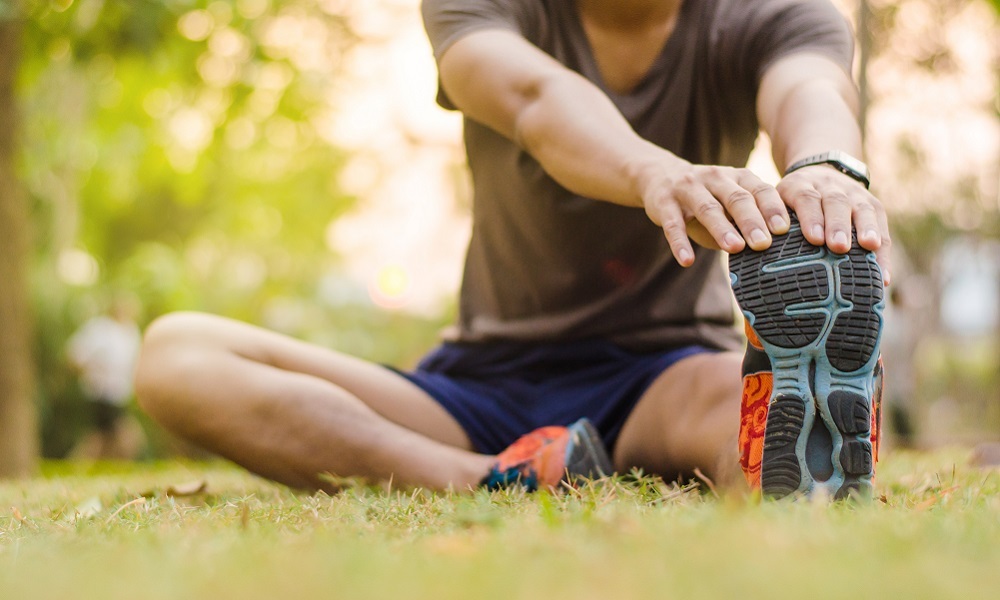Warming up before exercise is considered an important part of your overall fitness regime.
Warming up is said to help prevent injury, improve performance and prepare you for the task ahead. But, does the research back this up? And, if so, what is the most effective way to warm-up before exercise to ensure you gain those benefits?
Professor Anthony Blazevich is a Professor of Biomechanics in the School of Medical and Health Sciences at Edith Cowan University, and Director of the Centre for Exercise and Sports Science Research.
He says the historical belief was that doing some stretching in your warm-up was really good for improving your range of motion and making you feel like you have the mobility to do the exercises at hand. Static stretching (where we stretch and then hold the muscle at an extended length for seconds or minutes) was once considered an essential part of any sport or exercise warm-up, but is now a lot less common.
‘Around about the late 1990s and early 2000s, a few research papers came out that suggested that if you did lots of static stretching, you actually couldn’t produce as much muscle force. It was a very, very significant drop – some people were losing half their strength in the few minutes after stretching. And, this made people really question whether static stretching was really good for performance because of those force reductions,’ Blazevich tells Wellbeing by Teacher.
‘It is absolutely true that static stretching can reduce muscle force output but it turns out you need to stretch your muscle for about a minute for the majority of us to see a reasonable force reduction. Of course, very few people stretch a muscle for a minute, we’re lucky to hold it for 10 or 15 seconds,’ he explains.
Static or dynamic stretching?
Blazevich says that if you’re like most people and don’t do too much static stretching, but then follow it up with an exercise-based warm-up, by the time you actually perform you won’t actually see any performance decrement.
‘When static stretching is performed with a normal warm-up, we usually see an improvement in performance compared to not stretching. So overall, there’s either no change in performance, or there’s actually an improvement in performance, when you do relatively moderate amounts of stretching and combine it with a proper warm-up,’ he says.
‘So from a performance point of view, a lot of people would argue that there’s either no reason to exclude it, or maybe there’s some evidence that including it is positive. The weight of evidence is that it’s beneficial but it’s only a small effect.’
Dynamic stretching, by comparison, is an active movement where joints and muscles go through a full range of motion, for example when you perform lunges or high kicks. They can be used to help warm up your body before exercising. Blazevich says a lot of people will say that it’s better to get rid of static stretching and just do dynamic stretching if you’d like to improve performance. But, he believes it’s more complex than that.
‘The point is that it’s true that the research studies that have compared dynamic to static stretching have shown that dynamic stretching may enhance performance whilst static stretching may reduce it, but it comes back to experimental design,’ he says.
‘You and I both know that if you do lots of dynamic movement, your muscle temperature goes up and if you’ve got more muscle temperature, you perform better. And it’s a really fundamental fact that if muscles are warmer, they’ve got much more power output and this is important to remember.
‘When you’re doing dynamic stretching, it’s not so much the stretching itself that’s giving you this performance enhancement, it’s simply that you’ve got more muscle temperature.’
Blazevich says studies that combine dynamic stretching with a warm-up (which is already dynamic), don’t show enhancements. But, if you compare static stretching with dynamic stretching, both done with a warm-up, they perform equally well.
‘That’s because the stretching itself only has a very small effect on our performance outcomes,’ he says. ‘So dynamic stretching is not as amazing as everyone thinks. Basically if you’re doing nothing and then you do some dynamic exercise, you’re going to perform better.’
In terms of injuries, Blazevich says the weight of evidence is that a small amount static stretching in your warm-up will probably reduce your risk of muscle injury, especially if you’re in a running-based sport.
‘People who do static stretching in a warm-up tend to have a lower risk of muscle injuries in running-based sports,’ he says.
‘For example, soccer is the biggest sport on earth and hamstring injuries are the biggest injury in soccer. So if you’re talking about trying to reduce injury, it really does look like static stretching may have a benefit.’
Warming up before exercise
Blazevich says that it’s interesting to note the most effective way to warm up before exercise has largely remained unchanged for the past 40 years. He says you begin with a relatively low intensity, general warm-up. This could be stationary cycling, jogging, or something similar and it generally lasts for around five minutes.
You then progress to a more high intensity warm-up, focusing on a more specific skill. The idea behind this is if you practice a task, you become better at it. Blazevich says even elite athletes who have been performing at high levels for 10, 15, 20 years still improve performance if they do some very specific task practice, just before they compete.
‘If you move from general to specific and you take at least five minutes in each of those two sections, then you’re probably getting a decent warm-up. In other words, a good warm-up is unlikely to be less than 10 minutes.’
Blazevich says the benefits of warm-ups are plentiful, but the most important one is muscle temperature. When muscle temperature rises, you muscle power output improves.
‘As a bit of a general idea, you could expect about a five per cent improvement in power output for every one degree your muscles get warmer, and that’s measured in things like a bicycle sprint or a vertical jump or something like that,’ he says.
‘Most muscles sit around 34-35 degrees but will go up to 36-37 degrees during exercise. So, a warm-up before exercise gives you a two-degree, and maybe even a three-degree , rise so you can see your improvement in performance can be 10 or 15 per cent. In other words, the warming up of the muscle is really the key in a warm-up.’
Warming up and mentally preparing
Blazevich says that his team were one of the first groups to run a randomized, controlled trial in which they looked at the effect of stretching during a warm-up on your perception of how prepared you felt for the task ahead.
‘It turns out that regardless of whether you did static stretching or dynamic stretching, if you included some stretching within your warm-up (and this was a good warm-up that went from general to specific) you tended to rate your preparedness much higher,’ he says.
He says stretching gives you the opportunity to check your body for injury or tightness, which in turn improves your confidence. He adds the research also shows that stretching alters your sensory information and the way the body feeds information back about itself. So even if it doesn’t directly enhance performance, we certainly feel more ready to exercise or play sport afterwards.
Adding a warm-up to your daily exercise
Time seems to be the most significant reason why people tend to skip their warm-up before exercise. But for those looking for a simple way to embed it, Blazevich has a suggestion, but says it will depend on each individual person’s circumstances.
‘For example, if you take someone who has young children and they’re going to exercise alone by going for a run, the question is, how do you get them to do some sort of warm-up? In that case, I would simply say “incorporate your warm-up as part of your session”.
‘So start off with a light jog because remember the general warm-up is low intensity jogging anyway. Then, have a three-minute period where you jog a bit, and then you do a stretch of a muscle or around a joint for 10 seconds on each side, then jog a bit more and then choose another muscle group or joint.
‘And if you stop and stretch about five or six major muscle groups over those few minutes and then continue to run for the first five or 10 minutes of your run, then you can start running faster and faster. That would be the same as the specific part of the warm-up but of course, it doubles as your training session. Theoretically, you’re not increasing the time it takes to go for your run because and that way, you’ve got a very brief additional warm-up component that’s already built in. You can do something similar before playing sport – just do a few minutes of sport-specific warm-up at increasing intensity mixed with short muscle stretches as you go.’
How do you care for your own health and wellbeing? Do you have a story you’d like to share with Wellbeing by Teacher? Here’s a handy guide on how to get started.


